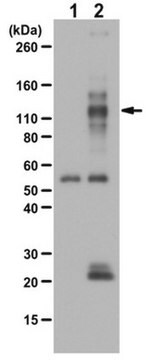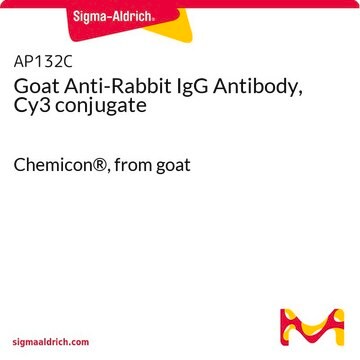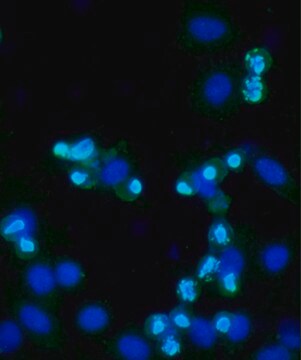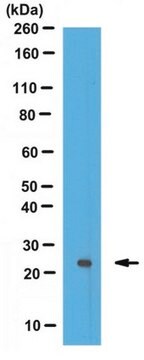AP132R
Goat Anti-Rabbit IgG Antibody, Rhodamine conjugate
Chemicon®, from goat
Sign Into View Organizational & Contract Pricing
All Photos(1)
About This Item
UNSPSC Code:
12352203
eCl@ss:
32160702
NACRES:
NA.46
Recommended Products
biological source
goat
Quality Level
conjugate
TRITC conjugate
rhodamine conjugate
antibody form
affinity purified immunoglobulin
antibody product type
secondary antibodies
clone
polyclonal
species reactivity
rabbit
manufacturer/tradename
Chemicon®
technique(s)
immunofluorescence: suitable
shipped in
wet ice
target post-translational modification
unmodified
Related Categories
Specificity
Rabbit IgG
WAVELENGTH:
Absorption peak = 550 nm, Emission peak = 570 nm.
WAVELENGTH:
Absorption peak = 550 nm, Emission peak = 570 nm.
Application
Goat anti-Rabbit IgG Antibody, Rhodamine conjugate is an antibody against Rabbit IgG for use in IF.
Research Category
Secondary & Control Antibodies
Secondary & Control Antibodies
Research Sub Category
Whole Immunoglobulin Secondary Antibodies
Whole Immunoglobulin Secondary Antibodies
Suggested dilution for most applications: 1:50-1:200 Optimal working dilutions must be determined by end user.
Physical form
Lyophilized. Buffer = 0.02 M Sodium Phosphate, 0.25 M NaCl, pH 7.6 with 15 mg/mL BSA, and 0.1% sodium azide.
RECONSTITUTION:
Reconstitute with 2 mL of sterile distilled water
RHODAMINE/PROTEIN:
Approximately 0.62 (A550/A280).
RECONSTITUTION:
Reconstitute with 2 mL of sterile distilled water
RHODAMINE/PROTEIN:
Approximately 0.62 (A550/A280).
Storage and Stability
Maintain lyophilized product at 2-8°C for up to 12 months. After reconstitution the product is stable for several weeks at 2-8°C as an undiluted liquid. For extended storage after reconstitution, add an equal volume of glycerol to make a final concentration of 50% glycerol followed by storage at -20°C in undiluted aliquots for up to 12 months. Please note the concentration of protein (and buffer salts) will decrease to one-half of the original after the addition of glycerol. Avoid repeated freeze/thaw cycles.
Legal Information
CHEMICON is a registered trademark of Merck KGaA, Darmstadt, Germany
Disclaimer
Unless otherwise stated in our catalog or other company documentation accompanying the product(s), our products are intended for research use only and are not to be used for any other purpose, which includes but is not limited to, unauthorized commercial uses, in vitro diagnostic uses, ex vivo or in vivo therapeutic uses or any type of consumption or application to humans or animals.
Not finding the right product?
Try our Product Selector Tool.
Hazard Statements
Precautionary Statements
Hazard Classifications
Aquatic Chronic 3
Storage Class Code
11 - Combustible Solids
WGK
WGK 3
Certificates of Analysis (COA)
Search for Certificates of Analysis (COA) by entering the products Lot/Batch Number. Lot and Batch Numbers can be found on a product’s label following the words ‘Lot’ or ‘Batch’.
Already Own This Product?
Find documentation for the products that you have recently purchased in the Document Library.
Commonly used reagents for visualizing Drosophila embryo structures.
Wendy F Rothwell,William Sullivan
CSH Protocols null
Effects of 530?nm Green Light on Refractive Status, Melatonin, MT1 Receptor, and Melanopsin in the Guinea Pig.
Wang F, Zhou J, Lu Y, Chu R
Current Eye Research null
Transplanted bone marrow stromal cells protect neurovascular units and ameliorate brain damage in stroke-prone spontaneously hypertensive rats.
Masaki Ito,Satoshi Kuroda,Taku Sugiyama,Katsuhiko Maruichi,Masahito Kawabori et al.
Neuropathology : Official Journal of the Japanese Society of Neuropathology null
Chromosome instability modulated by BMI1-AURKA signaling drives progression in head and neck cancer.
Chun-Hung Chou et al.
Cancer research, 73(2), 953-966 (2012-12-04)
Chromosomal instability (CIN) is widely considered a hallmark of cancer, but its precise roles in cancer stem cells (CSC) and malignant progression remain uncertain. BMI1 is a member of the Polycomb group of chromatin-modifier proteins that is essential for stem
Bor-Show Tzang et al.
Molecular medicine reports, 14(5), 4399-4406 (2016-10-26)
Human parvovirus B19 (B19) is harmful during pregnancy since it can be vertically transmitted to the developing fetus. In addition, the anti‑B19 antibodies induced by B19 infection are believed to have a cytopathic role in B19 transmission; however, knowledge regarding the
Our team of scientists has experience in all areas of research including Life Science, Material Science, Chemical Synthesis, Chromatography, Analytical and many others.
Contact Technical Service







